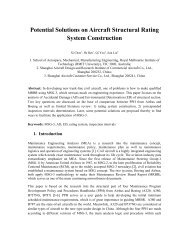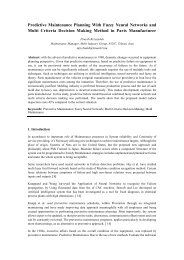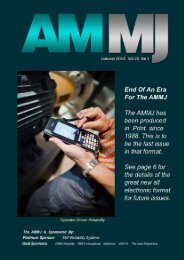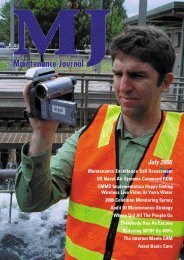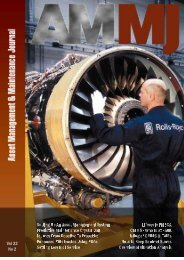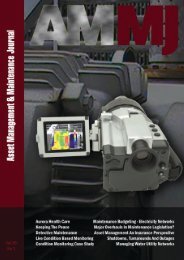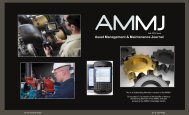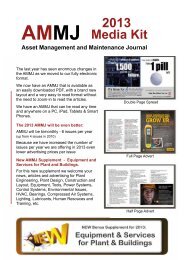July - AMMJ
July - AMMJ
July - AMMJ
You also want an ePaper? Increase the reach of your titles
YUMPU automatically turns print PDFs into web optimized ePapers that Google loves.
Frequency, (%)<br />
Effective Thickness 41<br />
<strong>AMMJ</strong><br />
Severe of Corroded Corrosion Steel Plates ; < 0.5<br />
tmin<br />
Here, the minimum thickness ratio ( ) is defined as: <br />
Py<br />
<br />
( yn / y ) ( bn / b ) yn y t eff = t 0 + (1-) (2) t min () te<br />
_ y <br />
t0<br />
By<br />
<br />
In this study, three different types of corrosion levels were introduced according to their severity of corrosion, and<br />
which can be used for reliable remaining strength estimation ( bn of / b actual ) corroded steel structures. They are;<br />
Py<br />
<br />
Minor Corrosion ; > 0.75 ( yn / y ) ( bn / b ) yn y t eff = t 0 + (1-) t min () te<br />
_ y <br />
bn<br />
By<br />
Py<br />
<br />
Moderate Corrosion ; 0.75 ≥ ≥ 0.5 ( yn / y ) ( bn / b ) yn y t eff = t 0 + (1-) t min () te<br />
_ y <br />
Py<br />
<br />
By<br />
<br />
Severe Corrosion ; < 0.5( yn / y ) ( bn / b ) yn y t eff = t 0 + (1-) t min () te<br />
_ y te<br />
By<br />
<br />
Further, the following Figure 5 shows the thickness histograms of three members which are classified in to the above<br />
mentioned corrosion categories. There, the significance of these three corrosion categories can be recognized from<br />
the features of those thickness histograms as well.<br />
Usually in minor corrosion members, many tiny corrosion pits (less than 3mm depth) can be seen through out the<br />
specimen. Figure 5(a) shows that the peak of thickness histogram is almost the same as its average thickness for<br />
the minor corrosion type members. Further, it can be seen that the distribution width of the thickness histogram is<br />
very narrow.<br />
In moderate corrosion type members, though there are few considerable corroded pits (depth of 3-5 mm) exist<br />
in some places, many non-corroded portions also remain widely. Further, as it can be seen from Figure 5(b), the<br />
thickness distribution is larger than that of the minor corrosion members and the peak of thickness histogram is not<br />
the same as the average thickness of the member.<br />
60<br />
50<br />
40<br />
30<br />
20<br />
10<br />
Average thickness (t avg ) : 9.40 mm<br />
Standard deviation ( st ) : 0.11 mm<br />
Minimum thickness (t min ) : 8.68 mm<br />
Minimum thickness ratio (<br />
(a)<br />
0 2 4 6 8 10<br />
Thickness [mm]<br />
Figure 5<br />
When the corrosion is more progressed, severe corrosion type can be seen with several extensive corroded regions<br />
(maximum corrosion depth over 5mm and the diameter of the corroded pits are exceeding 25mm) on the member.<br />
Usually in severe corroded members, few peaks of the thickness histogram can be seen as shown in Figure 5(c),<br />
and the highest peak is widely different from the average thickness as well.<br />
So, it is clear that the average thickness could not be able to use for the strength estimations of members with<br />
moderate or severe corrosion conditions.<br />
100<br />
3.4 Experimental Results<br />
Load-elongation curves for three different corroded<br />
specimens and one corrosion-free plate are shown in 80<br />
Figure 6.<br />
FT-22 and FT-18 have comparatively larger minimum<br />
Py<br />
<br />
thickness ratio ( = 0.827 ( yn /and y ) (0.632 bn / b ) respectively) yn y t eff = tand 0 + (1-) the t min () te<br />
_ y <br />
specimen FT-15 has comparatively lesser value of it ( =<br />
60 By<br />
<br />
0.469). Further it can be seen that the steel plate FT-5,<br />
in which the corrosion progression was more severe, the<br />
minimum thickness ratio is also diminutive ( =0. 231). 40<br />
Herein, the specimen (FT-22) with minor corrosion has<br />
almost the same mechanical properties (such as apparent<br />
yield strength and load-elongation behavior etc.) as the<br />
20<br />
corrosion-free specimen (FM-5).<br />
On the other hand, the moderately corroded specimen<br />
(FT-18) and the severe corroded (in this case, locally)<br />
specimen (FT-15) show obscure yield strength (Figure<br />
6). And the elongation of the specimen FT-15 decreases<br />
significantly. The reason for this is believed to be that the<br />
local section with a small cross-sectional area yields<br />
Frequency, (%)<br />
60<br />
50<br />
40<br />
30<br />
20<br />
10<br />
Average thickness (t avg ) : 9.01 mm<br />
Standard deviation ( st ) : 0.60 mm<br />
Minimum thickness (t min ) : 6.64 mm<br />
Minimum thickness ratio (<br />
(b)<br />
Minor Corrosion ; > 0.75<br />
Moderate Corrosion ; 0.75 0.5<br />
0 2 4 6 8 10<br />
Thickness [mm]<br />
Frequency, (%)<br />
60<br />
50<br />
40<br />
30<br />
20<br />
10<br />
Average thickness (t avg ) : 7.77 mm<br />
Standard deviation ( st ) : 0.97 mm<br />
Minimum thickness (t min ) : 4.92 mm<br />
Minimum thickness ratio (<br />
(c)<br />
0 2 4 6 8 10<br />
Thickness [mm]<br />
Thickness histigrams of (a) Minor corrosion type FT-22, (b) Moderate corrosion type (FT-18)<br />
and (c) Sever corrosion type (FT-15)<br />
Load (kN)<br />
Py<br />
<br />
( yn / y ) ( bn / b ) yn y t eff = t 0 + (1-) t min () te<br />
_ y <br />
By<br />
<br />
FM-5 (Corrosion-free plate)<br />
FT-22 (Minor Corrosion)<br />
FT-18 (Moderate Corrosion)<br />
FT-15 (Severe Corrosion)<br />
0 5 10 15 20<br />
Elongation, (%)<br />
Figure 6<br />
Load - elongation curves<br />
t<br />
_ b<br />
Vol 24 No 3<br />
e<br />
Pb<br />
<br />
<br />
B b<br />
<br />
Pb<br />
<br />
te<br />
_ b <br />
B b<br />
( yn / y ) ( bn / b ) yn y t eff = t 0 + (1-) t min Py<br />
<br />
() te<br />
_ y <br />
By<br />
<br />
t<br />
e<br />
_ b<br />
te _ b<br />
_ b<br />
te<br />
<br />
<br />
Pb<br />
<br />
<br />
B b




